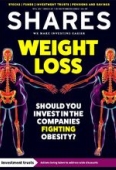Archived article
Please note that tax, investment, pension and ISA rules can change and the information and any views contained in this article may now be inaccurate.
Weight loss: should you invest in the companies fighting obesity?

Obesity is one of the fastest growing public health issues facing the world. The World Health Organisation estimates there are two billion overweight adults, of which around 650 million are technically obese.
Having a body mass index over 30 means someone is obese, while anyone with a score over 25 is classified under this system as being overweight. Experts predict almost half of US adults will be obese by the end of the decade.
Obesity can result in chronic health problems including diabetes. Four years ago, the Organisation for Economic Co-operation and Development reported that nearly one in three adults suffered from obesity in the UK, the highest in Europe.
There are 415 million people globally suffering from diabetes which is forecast to reach 642 million by 2042 according to diabetes.co.uk. The global diabetes therapeutics market is worth around $62 billion and expected to double by 2032 based on forecasts from Precedence Research.
Barclays pharmaceuticals analyst Emily Field estimates the global market for obesity drugs could top $100 billion by 2030.
While investor focus has rightly been on companies developing treatments, Shares believes there is a wider story to tell with increasing scrutiny on certain types of food and their link to obesity and other diseases.
In other words, rather than just looking at the opportunities for treating the disease there may be hidden risks lurking in the food producers which are underappreciated by investors. As we explain later, it is not the foods which are the problem but the way in which they are industrially manufactured.
FIGHTING OBESITY
Danish insulin specialist Novo Nordisk (NVO:NYSE) has been at the forefront of developing effective diabetes and weight management treatments.
Novo Nordisk is one of the big three insulin makers which collectively control around 89% of the global insulin market. The other two players are Eli Lilly (LLY:NASDAQ) and French pharma company Sanofi (SAN:EURONEXT).
The company’s success is reflected in it becoming Europe’s most valuable listed company, overtaking luxury goods group LVMH (MC:EURONEXT) in the process.
Novo Nordisk’s shares have almost doubled over the last year driven by the success of its weight management treatment Wegovy which sells as Ozempic in the US.
Clinical trials showed patients taking the drug lost around 15% of their body weight after 68 weeks with most people seeing a difference in the first month.
A multi-year clinical trial of Wegovy showed it also reduced the risk of major heart attacks and strokes by 20%. Novo Nordisk plans to file for regulatory approvals for these added benefits
in 2023.
Demand for the drug, which was authorised as a treatment for obesity in 2021, has benefited from celebrities using it such as entrepreneur Elon Musk and actor Amy Schumer. Former UK prime minister Boris Johnson also took the drug after he noticed colleagues suddenly getting thinner. Notably, both Schumer and Johnson said they stopped taking it due to unpleasant side effects.
Before rushing out to buy Novo Nordisk shares, it is worth pointing out there are other companies in the race to develop obesity drugs so it is not a one-man race.
COMPETITION FROM ELI LILY AND OTHERS
Eli Lilly’s obesity drug Mounjaro could potentially receive approval by the regulator by the end of 2023 and clinical trials demonstrated it achieved greater weight loss than Wegovy with patients losing up to 26% of their bodyweight.
The FDA last year approved Mounjaro for treating type two diabetes in the US. The National Institute for Health and Care Excellence earlier this month published draft guidance approving the use of Mounjaro for treating type two diabetes in England and Wales, with it likely to be available through the NHS by early 2024.
Meanwhile, Wegovy launched in the UK on 5 September for use in the NHS and private practices despite Novo Nordisk struggling to keep up with demand.
The opportunity to get its foot in the door before Ely Lilly’s Mounjaro is authorised by the regulator for treating obesity may have been a factor in Novo’s decision to launch with limited stock.
Although Novo and Eli Lilly have a lead over the chasing pack neither company is resting on its laurels with both developing oral versions of their treatment. Wegovy is currently self-injected weekly.
Big pharma companies Pfizer (PFE:NYSE) and Amgen (AMG:NYSE) are also in the race to develop obesity drugs.
While investors place their bets on the potential winners from treating obesity it is also worth considering the role that food companies play in the obesity debate.
There are parallels between the tobacco industry and the food industry in that both sell addictive products. As the science unfolds on the causes of obesity, increased regulation is a potential risk to food manufacturers. That suggests investors might want to think about which stocks to avoid as a result of the obesity problem as well as ones to benefit from the provision of treatments.
WHAT CAUSES OBESITY?
There is an increasing body of evidence that certain heavily processed foods have detrimental effects on the body. This is a new phenomenon. For centuries humans got by without becoming seriously overweight.
We have an inbuilt mechanism (a protein made in the stomach) which tells the brain when we are full.
Around 40 years ago food manufacturing companies started to introduce ingredients which made food less expensive to mass-produce and therefore cheaper for consumers to purchase.
These foods looked good, tasted good and had a longer shelf life. Win-win for food companies and consumers, right?
Absolutely not. Today these industrially-made foods are ‘ultra processed’ and because they have little nutritional benefit, they can encourage overeating, say the experts.
Proteins in the stomach normally signal to the brain when it is full. These proteins fail when unhealthy, unbalanced ‘food stuffs’ encourage overeating, explains Chris van Tulleken, author of the book Ultra-Processed People.
Scientists believe the rapid rise in global obesity has a direct link to increased consumption of ultra-processed foods. Results of a study published in 2020 involving 110,260 patients over a 10-year period showed a higher consumption of ultra-processed foods is associated with weight gain and obesity. Subsequently, public health authorities in several countries have started to recommend limiting intake of ultra-processed foods.
WHAT ARE ULTRA-PROCESSED FOODS?
Ultra-processed foods and beverages are products with additives and industrially processed ingredients technologically broken down and modified.
In simple terms ultra-processed foods contain ingredients you will not find in your kitchen. Typically, they contain additives, artificial flavourings, emulsifiers (binding solution) and preservatives which increase shelf life.
They tend to be energy dense but low in nutrients. In other words, ultra-processed foods contain little natural foods such as meat, fruit, vegetables, seeds, eggs or milk. Examples include confectionery, fried snacks, processed meats, cakes and biscuits. The UK is one of the biggest consumers per head of ultra-processed foods in Europe.
The Nova food classification system is a recognised tool for categorising types of food. It is comprised of four categories with ultra-processed foods being the fourth.
WHICH COMPANIES MAKE ULTRA-PROCESSED FOODS?
An analysis based on a representative sample of 15 to 30 products collected by Tortoise from 30 food companies showed seven out of 10 food items were ultra-processed.
Eleven companies in the sample sell ultra-processed foods cheaper than non-ultra-processed foods measured by calories per pound. These include Kraft Heinz (KHC:NASDAQ), Cadbury’s chocolate maker Mondelez International (MDLZ:NASDAQ), cooked meats purveyor Cranswick (CWK), specialist foods supplier Hilton Food (HFG) and Birds Eye.
The top 10 companies with the highest profit margins in the sample generated 85% of their revenue from ultra-processed foods, says Tortoise.
Selling ultra-processed foods is profitable despite the lower price point and because they are a cheaper source of energy, they are consumed by lower socio-economic segments of society.
WHAT CAN BE DONE?
Tortoise argues that one option is to add a levy like the sugar tax imposed on soft drinks manufacturers in 2018. The problem with this approach is that clarity is needed on definitions and targets.
‘Unless all companies have the same rules, they won’t risk their market share to make these changes and our population will continue to suffer,’ explains Tim Spector, professor of genetic epidemiology at King’s College London.
The scientific definition for ultra-processed foods runs to four pages according to van Tulleken. His preferred solution is to stick a black label on foods containing ultra-processed foods to inform consumers of the health risks. Unfortunately, certain companies simply refuse to accept the Nova classification system.
GAMING THE SYSTEM
There is evidence that international food and drink companies are following the playbook of the tobacco companies and funding research to take control of the health debate.
For example, in 2015 the New York Times reported that Coca Cola (KO:NYSE) was covertly funding the Global Energy Balance Network, set up to promote the message that all calories are equal. The idea was to show that sweetened beverages were not responsible for obesity.
Writing in the British Medical Journal, Gyorgy Scrinis argues that ultra-processed food corporations use similar strategies not only to ‘influence the nutritional knowledge related to their products but also to shape the broader concepts that frame scientists and the public’s understanding of food and the body’.
WHAT CONCLUSIONS CAN BE DRAWN?
Obesity and diabetes are on the rise across the globe which equates to billions of suffering people and billions of dollars of medical costs.
This has presented a big opportunity for pharma companies to help alleviate the suffering by developing effective treatments. Novo Nordisk and Eli Lilly are ahead in the race, but other companies may yet develop better drugs.
Novo trades on a high PE (price to earnings) ratio of around 38 times expected 2023 earnings per share and 32 times 2024 earnings per share. Eli Lilly has a bigger market cap than Novo and trades on an even higher PE of 61 times for 2023 and 47 times for 2024.
Both shares are at all-time highs reflecting the excitement around obesity drugs. They are great businesses yet it would be prudent to wait for a better buying opportunity given their elevated valuations. Watch the shares closely and snap them up if you see any share price weakness.
The scientific evidence linking certain types of food such as ultra-processed foods to obesity is building and may yet result in more regulation on food companies. This risk is underappreciated by the market and so anyone owning any food stocks in their portfolio might want to reconsider if they are still appropriate as investments.
Important information:
These articles are provided by Shares magazine which is published by AJ Bell Media, a part of AJ Bell. Shares is not written by AJ Bell.
Shares is provided for your general information and use and is not a personal recommendation to invest. It is not intended to be relied upon by you in making or not making any investment decisions. The investments referred to in these articles will not be suitable for all investors. If in doubt please seek appropriate independent financial advice.
Investors acting on the information in these articles do so at their own risk and AJ Bell Media and its staff do not accept liability for losses suffered by investors as a result of their investment decisions.
Issue contents
Feature
Great Ideas
Investment Trusts
News
- TSMC spooks chip industry with slowdown threat
- Centrica share price rally has been ‘meteoric’, up 420% since 2020
- Frasers could be the key to Shein becoming a bigger player in the UK
- Drax shares tank on fears over new report on UK Government biomass strategy
- Bakkavor shares remain in the doldrums after workers vote to strike

 magazine
magazine








